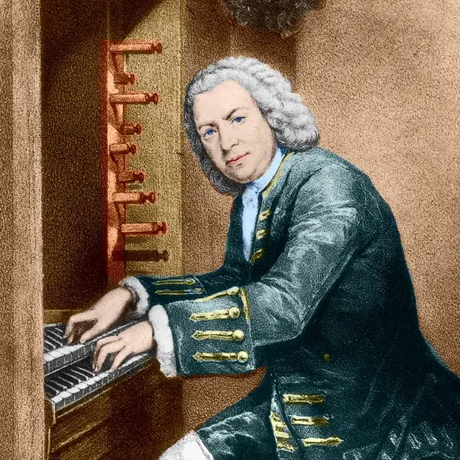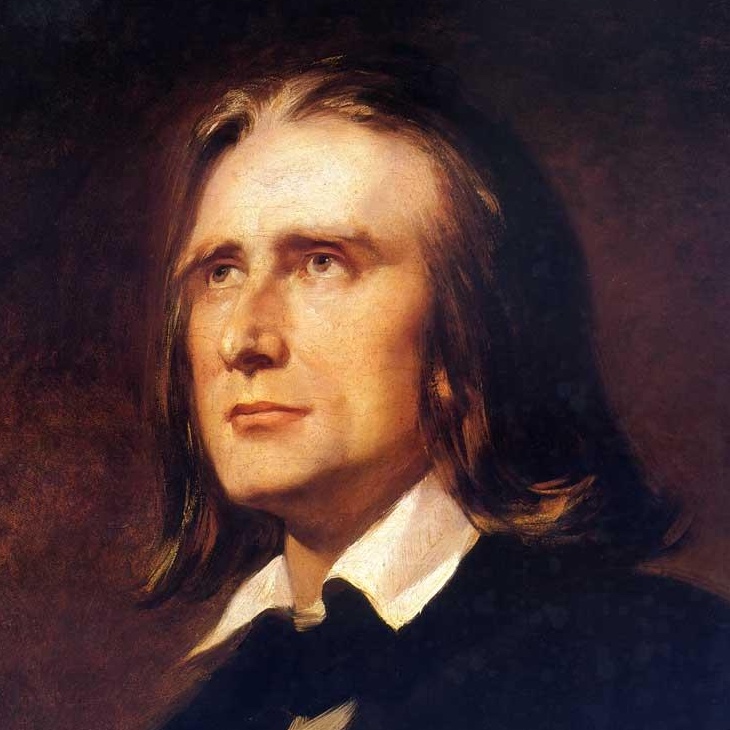Madison Symphony Orchestra Program Notes
Overture Concert Organ
Series No. 2
October 25, 2022
J. Michael Allsen
We
welcome organist Christopher Houlihan for this second
concert of our organ series. He opens with one
of the most
frequently-played works by Bach, the Prelude and Fugue in A minor, BWV 543. Robert Edward Smith’s An
Introduction to the King
of Instruments will be an
enjoyable “guided tour” of the Overture Concert Organ...narrated by our own Greg
Zelek. Mr. Houlihan concludes
with Franz Liszt’s monumental Fantasy
and
Fugue on “Ad nos, ad salutarem undam.”
 Johann
Sebastian Bach
(1685-1750)
Johann
Sebastian Bach
(1685-1750)
Prelude and Fugue in A minor, BWV 543
Bach’s
earliest professional position, at age 17, was in Weimar, at
the court of Duke
Johann Ernst III. Bach later described his position as a
“court musician,” but
the court records actually describe him as a
“lackey”—low-ranking musicians
were apparently also expected to perform more menial work.
It is probably not
surprising that Bach left Weimar after only six months to
take a much more
attractive position as a church organist in Arnstadt, where
he worked from
1703-07. After serving in a second organ position in
Mühlhausen (1707-08), he
was lured back to Weimar. The court organist, Johann Effler,
had finished
extensive renovations to the organ in the Duke’s chapel, but
his health was
failing. Knowing Bach’s growing reputation as an organ
virtuoso and as an
expert on organ construction, Effler invited Bach to Weimar
to inspect the
instrument and play an inaugural recital for the Duke in
June of 1708. Bach was
immediately offered the position of court organist. (Don’t
worry: the ailing
Johann Effler was able to retire comfortably, with his full
salary!) By July
1708, Bach was in Weimar, where he would remain until 1717,
eventually serving
as Konzertmeister
(music director).
.
In his early years at Weimar, Bach
concentrated primarily on
keyboard works: many of the 48 preludes and fugues later
published as The
Well-Tempered Clavier were written
there, as were all but three of the 46 Lutheran chorale
preludes published in
his Orgelbüchlein.
The Prelude and Fugue
in A minor also comes
from this productive period. One of the prime influences on
this work—and on
many of his early organ works—was the style of his
acknowledged master,
Dieterich Buxtehude. In 1705, the 20-year-old Bach took a
leave from his church
position in Arnstadt to walk 280 miles to Lübeck, where he
hoped to study with
Buxtehude—the only truly long journey Bach ever made. Though
he was not exactly
AWOL from Arnstadt, his employers complained that Bach had
requested a
four-week leave, but stayed away for “about four times that
long.” Just how
much he actually studied with Buxtehude is unclear, but
several of his organ
works over the next few years—including the masterful Prelude and Fugue in A minor
heard here—clearly show his admiration for Buxtehude’s
music.
The Prelude begins
with a winding, subtly chromatic line in the manuals,
eventually joined by a
long-held pedal. The pedals and manuals then begin to
explore the opening
material together, all the way through to a dramatic
conclusion. The Fugue
is set in 6/8, lending a dancing
quality to this intensely complex work. In the opening, the
fugue subject is
presented four times, lastly by the pedals. The fugue
includes some long,
chromatic episodes—typically passages without the fugue’s
opening subject,
though Bach subtly manages to work in fragments of this
theme. The ending is
dramatic: the writing for the manuals fades away, leaving
the pedals exposed
for a final showy passage. The work ends with a brilliant
flourish from the
manuals.
 Robert
Edward
Smith (b. 1946)
Robert
Edward
Smith (b. 1946)
An
Introduction
to the King of Instruments: Variations on an American
Folk Tune
Composer, harpsichordist, and church
musician Robert Edward Smith joined
the faculty of Trinity
College (Hartford, CT)
in 1979 and served as composer-in-residence
there.
He also taught at the Hartt
School of Music from 1995-2011. As a composer, Smith
has written music
for vocal and instrumental ensembles of all sizes ranging
from unaccompanied
viola to symphony orchestra, as well as the 2011 chamber
opera A
Place of Beauty,
on the life of art collector and philanthropist Isabella
Stewart Gardner. His
published music includes many sacred choral pieces and works
for organ. As a
harpsichordist, Smith holds the distinction of being the
first person since the
18th century to perform in public the complete harpsichord
literature of
François Couperin. He was also a working church musician for
nearly 50 years. Smith
currently lives in Boston and devotes himself to
composition. He
composed the work heard here in 1978, and notes that:
“The
variations were composed on commission from Michael Nemo,
who was the founder
of Towerhill Records. He wanted to produce a recording
that illustrated to the
listener what sounds a well-designed pipe organ could
produce, taking as his
model Britten’s Young Person’s Guide to the Orchestra.
The commission
was specifically for the recording, and would feature John
Rose as organist
playing the organ at Saint Joseph’s Cathedral in Hartford,
CT. Mr. Rose
performed it live at Trinity College Chapel in Hartford
after the recording was
made.”
This
is one of a few works by Smith that draw upon the rich
heritage of early
American hymnody. In this case, it is the tune Pisgah. This melody, attributed to J.C.
Lowry (possibly Joseph C.
Lowery), which first appeared in the shape-note collection The Kentucky Harmony in 1816. “Shape-note” or “Sacred Harp”
music is a uniquely
American tradition, beginning in the late 18th century.
Four-part hymns,
anthems, and “fuging tunes” were printed in a notation in
which
variously-shaped noteheads represented solfege syllables.
This music often has
a rough-edged, sturdy beauty, and many of these tunes
survive in modern
hymnals. In the case of Pisgah, it is
usually paired with the 18th-century Isaac Watts hymn When I Can Read My Title Clear. In
describing the variations, Smith
writes:
“Each
variation features a particular rank of pipes: principals,
flutes, reeds,
mixtures, etc., each of which is introduced by the
narrator. After the
last variation, the work ends with a rondeau, which
repeats the order of ranks
presented in the variations, but without the vocal
introduction. The rondeau
ends with its theme played above the hymn tune as a sort
of hymn descant.”
 Franz
Liszt (1811-1886)
Franz
Liszt (1811-1886)
Fantasy
and
Fugue on “Ad nos, ad salutarem undam”
Franz Liszt was the preeminent piano
virtuoso of the 19th
century, and the model for many pianists to follow. He was
also an imaginative
and ground-breaking composer, but as a young man, he was so
much in demand as a
soloist that he was allowed little time to develop his
composing skills. Liszt’s
concert tours in the 1830s and 1840s were nothing short of
sensational—contemporaries
used the term “Lisztomania” to describe the frenzy
surrounding his playing. He
performed hundreds of concerts to packed houses throughout
Europe, and produced
for the most part compositions that focused on his own
technical showmanship,
rather than musical content.
It was not until he settled in Weimar in 1848, taking a
secure and stable job
as music director to the Weimar court, that Liszt’s music
takes a turn away
from these showy pieces.
In 1848, Liszt
attended the premiere of Giacomo Meyerbeer’s huge,
five-act grand opera Le prophète in
Paris and was deeply
impressed. Le
prophète, set against
the background of Dutch religious upheaval in the early
16th century, is based
upon the life of the Anabaptist leader John of Leiden.
John was able to
establish a religious state in the city of Münster,
proclaiming himself “King
of New Jerusalem,” before his eventual downfall and death
by torture. Liszt
studied Meyerbeer’s score closely, and in 1849-50
completed a set of three Illustrations du
Prophète for solo
piano. Virtuoso transcriptions of music from popular
operas were nothing new at
the time—Liszt himself had written dozens of them in
previous years—but the Illustrations du
Prophète were built on
another scale. This set, lasting nearly 40 minutes in
total, very freely adapts
Meyerbeer’s music, sometimes reordering and fragmenting
themes to make new
musical connections. In the winter of 1850, he completed
what was essentially a
fourth Illustration
from the opera,
his Fantasy and
Fugue on “Ad nos, ad salutarem undam”—this
one written not
for piano but rather for organ. Liszt became interested in
the organ during in
his Weimar years, at least partly inspired by a deep
reverence for Bach—who had
of course held the same the same job as Liszt in Weimar
135 years earlier. The Fantasy
and Fugue was the first of some 45
works for organ Liszt
would compose over the next 20 years. However, though
Liszt was a phenomenal
pianist, he was less skilled as an organist; in
particular, he never seems to
have mastered the pedals. The work was premiered by one of
his students,
Alexander Winterperger, as part of the dedication of a new
organ in Merseberg
Cathedral, on September 26, 1855.
The Fantasy
and
Fugue is
an enormous virtuoso
work, sprawling over some 765 measures, and lasting nearly
half an hour. In the
opera, the chorale Ad
nos, ad salutarem undam (Come
to us, to the
waves of salvation) is sung by a trio of sinister
Anabaptist priests, who
will eventually have a hand in John of Leiden’s
destruction. It appears in the
opera’s first act, as the priests recruit peasants to
start a religious
rebellion. Meyerbeer apparently found the melody in a
17th-century hymnal. Liszt’s Fantasy and Fugue
is laid out in three
large sections, opening with a brief and dissonant
introduction, before he
introduces the rather creepy chorale melody. After a
mysterious, atmospheric
transition, Liszt begins a long, free development of this
theme. After the
music reaches a roaring climax, there is another quiet
transition into the
second large section (Adagio). This
opens with a simple, unadorned statement of the melody,
and moves through six
calm variations. This section closes with an agitated and
highly dissonant
passage—Liszt makes extensive use of the whole-tone scale
here—that leads into
the Fugue. In
keeping with the
dimensions of the Fantasy,
the Fugue is
massive, some eight minutes
long. This was the first time Liszt used a fully-developed
fugue in his works,
though he uses a thoroughly unorthodox version of this
traditional form. The
piece ends with a colossal, fiercely triumphant statement
of the chorale.
________
program
notes ©2022 by J.
Michael Allsen